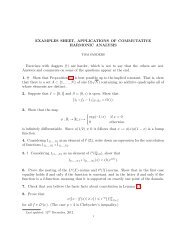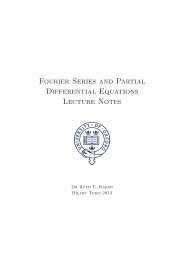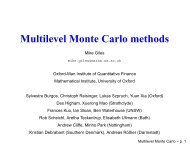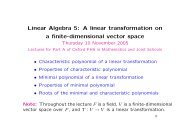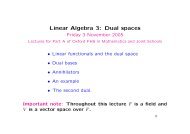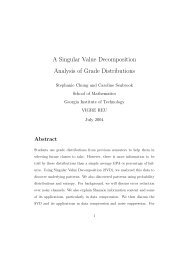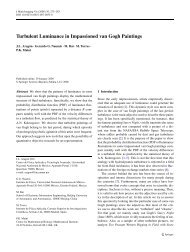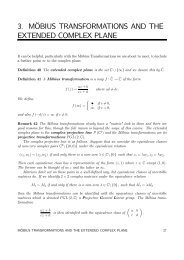Construction of Hyperkähler Metrics for Complex Adjoint Orbits
Construction of Hyperkähler Metrics for Complex Adjoint Orbits
Construction of Hyperkähler Metrics for Complex Adjoint Orbits
Create successful ePaper yourself
Turn your PDF publications into a flip-book with our unique Google optimized e-Paper software.
3.3 Regular Nahm Solutions and Line bundles on S 28<br />
We recall that the solution is obtained in the following two steps:<br />
(i) Letting Vs = H 0 (S, ML s (k − 1)), one obtains endomorphisms Ã0(s),<br />
Ã1(s), Ã2(s) <strong>of</strong> Vs, determined by requiring that<br />
<strong>for</strong> all σ ∈ Vs.<br />
(η + Ã0(s) + ζ Ã1(s) + ζ 2 Ã2(s))σ = 0 (3.6)<br />
(ii) In order to arrive at A(s, ζ), one defines a vector bundle V over<br />
(−∞, 0] whose fibre over s is Vs, and then one constructs a connection<br />
on V which is used to trivialise V by taking a basis <strong>of</strong> covariant constant<br />
sections. The matrices <strong>of</strong> the endomorphims Ã0(s), Ã1(s), Ã2(s) with re-<br />
spect to this basis, denoted by A0(s), A1(s), A2(s), are such that A(s, ζ) =<br />
A0(s) + A1(s)ζ + A2(s)ζ 2 corresponds to a solution to Nahm’s equations<br />
defined on (−∞, 0].<br />
In fact, <strong>for</strong> our purposes it will be enough to describe A(s, ζ) up to con-<br />
jugation; note that if we take the matrices <strong>of</strong> the endomorphisms Ã0(s),<br />
Ã1(s), Ã2(s) with respect to any basis <strong>of</strong> Vs, <strong>for</strong> each s ∈ (−∞, 0], then we<br />
obtain a k × k matrix [ Ã(s, ζ)] which is <strong>of</strong> the <strong>for</strong>m g(s)A(s, ζ)g(s)−1 with<br />
g(s) ∈ GL(k, C). We shall see that one may find a suitable basis <strong>for</strong> which<br />
the coefficients <strong>of</strong> [ Ã(s, ζ)] are rational functions in eλ1s , . . . , e λks .<br />
Let us discuss next the requirement that the Nahm solutions obtained by<br />
the method described in (i) and (ii) should be suk-valued.<br />
3.3.1 Reality<br />
The method <strong>of</strong> producing solutions to Nahm’s equations out <strong>of</strong> line bundles<br />
on the spectral curve gives us, in general, only gl(k, C)−valued solutions.<br />
In order to obtain suk−valued solutions, we must impose further conditions<br />
on the line bundle. In [Hit83] it is shown how one can obtain skew-adjoint




